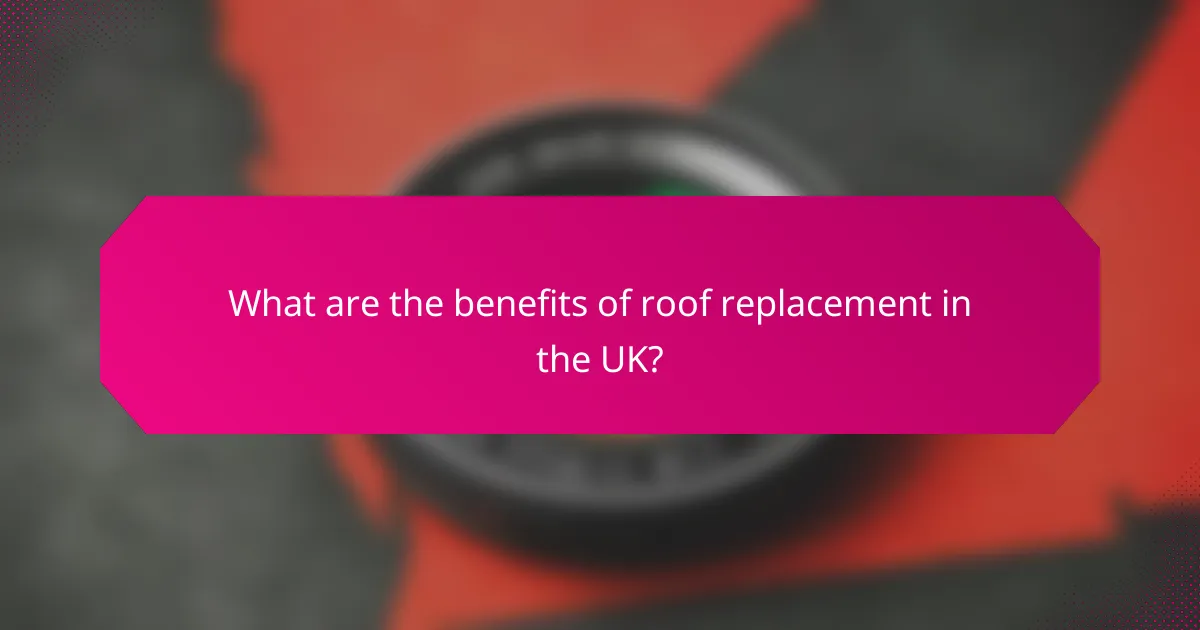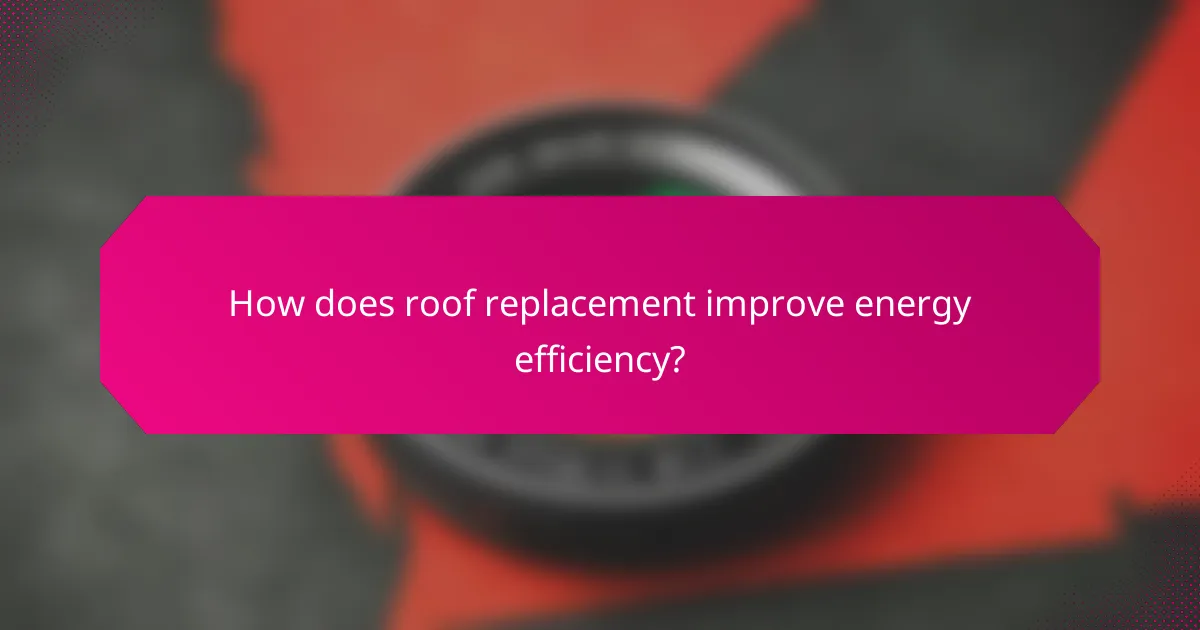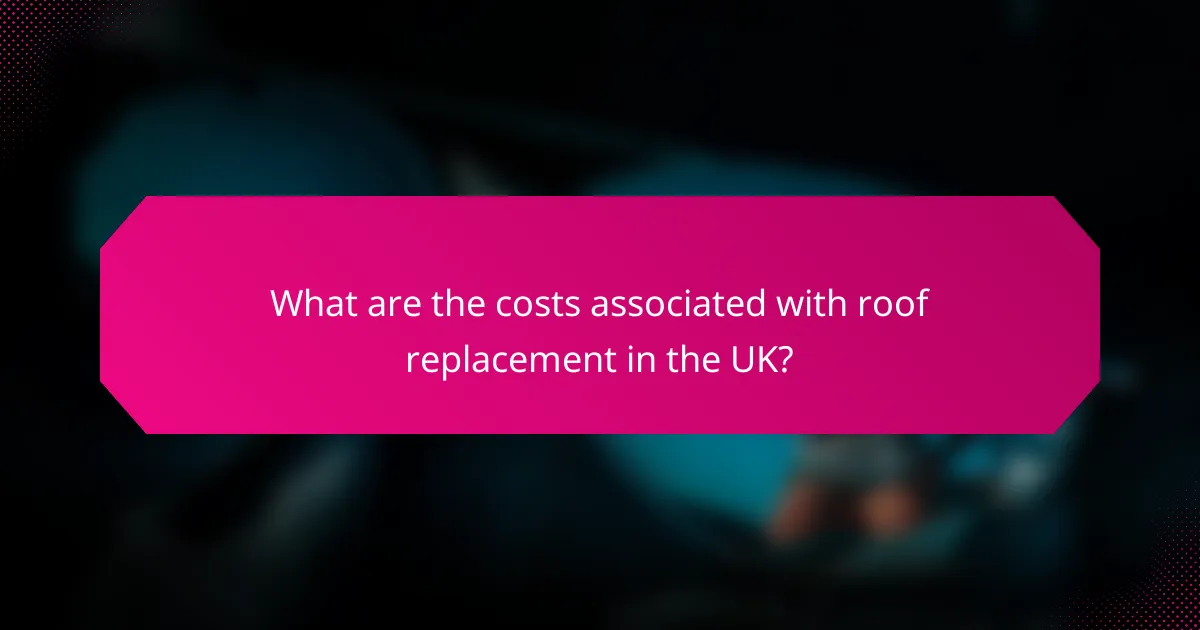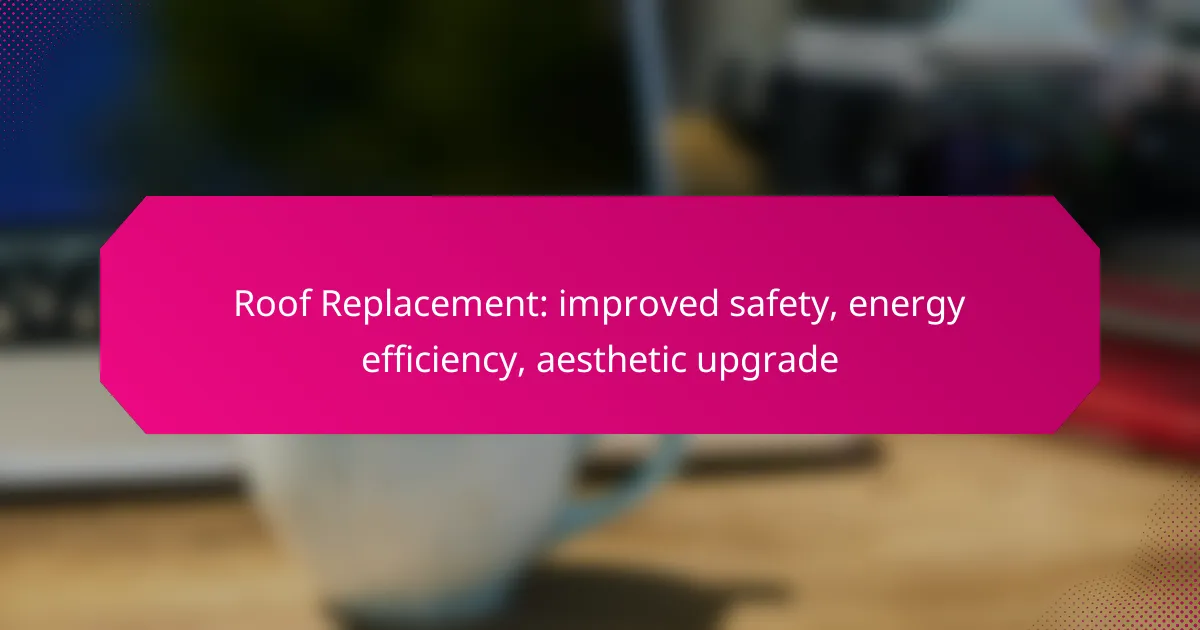Roof replacement is a vital home improvement that not only enhances safety but also boosts energy efficiency and elevates the aesthetic appeal of your property. By investing in modern materials and techniques, homeowners can enjoy reduced energy costs and a more comfortable living environment. Additionally, a new roof can significantly increase property value, making it a worthwhile investment for any homeowner.

What are the benefits of roof replacement in the UK?
Roof replacement in the UK offers several advantages, including enhanced safety, improved energy efficiency, increased property value, and aesthetic upgrades. These benefits can significantly impact the comfort, cost-effectiveness, and appeal of a home.
Enhanced safety standards
Replacing an old roof can greatly enhance safety by ensuring compliance with current building regulations and standards. New roofing materials are designed to withstand harsh weather conditions, reducing the risk of leaks and structural failures.
Homeowners should consider hiring certified professionals who follow safety protocols during installation. This not only protects the workers but also ensures the roof is installed correctly, minimizing future hazards.
Improved energy efficiency
A new roof can lead to improved energy efficiency, which is crucial for reducing heating costs in the UK. Modern roofing materials often feature better insulation properties, helping to maintain a consistent indoor temperature.
Investing in energy-efficient roofing can lower energy bills by up to 20-30%. Homeowners should look for materials with high thermal performance ratings and consider options like reflective coatings to further enhance efficiency.
Increased property value
Roof replacement can significantly increase a property’s market value, making it a worthwhile investment. A new roof not only improves curb appeal but also assures potential buyers of the home’s structural integrity.
In the UK, a well-maintained roof can add thousands of pounds to a property’s value. Homeowners should keep records of the replacement process and materials used to showcase the investment to future buyers.
Aesthetic upgrades
Replacing a roof provides an opportunity for aesthetic upgrades that can transform the look of a home. Homeowners can choose from a variety of materials, colors, and styles that complement their property’s architecture.
Consider options like slate, tile, or metal roofing, which can enhance visual appeal while providing durability. A new roof can make a significant difference in the overall appearance and attractiveness of a property, contributing to its charm and character.

How does roof replacement improve energy efficiency?
Roof replacement can significantly enhance energy efficiency by utilizing modern materials and techniques that reduce heat loss and improve insulation. This leads to lower energy bills and a more comfortable indoor environment throughout the year.
Insulation upgrades
Upgrading insulation during a roof replacement is crucial for maximizing energy efficiency. High-quality insulation materials, such as spray foam or rigid foam boards, can minimize heat transfer, keeping homes warmer in winter and cooler in summer. Properly installed insulation can reduce energy costs by 20-30%.
When selecting insulation, consider the R-value, which measures thermal resistance. Aim for an R-value that meets or exceeds local building codes, typically ranging from R-30 to R-60 in colder climates.
Energy-efficient materials
Using energy-efficient roofing materials can greatly impact a home’s energy performance. Options like cool roofs, which reflect more sunlight and absorb less heat, help lower cooling costs during hot months. Metal, tile, and certain asphalt shingles can also provide better insulation compared to traditional materials.
When choosing materials, look for those with ENERGY STAR ratings or similar certifications, which indicate superior energy performance. This can lead to long-term savings and may qualify for local rebates or incentives.
Ventilation improvements
Improving ventilation is essential for maintaining energy efficiency in a roof replacement. Proper ventilation helps regulate temperature and moisture levels in the attic, preventing heat buildup and reducing the workload on HVAC systems. This can extend the lifespan of both the roof and the heating/cooling systems.
Consider installing ridge vents, soffit vents, or gable vents to enhance airflow. Ensure that the ventilation system is balanced, allowing for adequate intake and exhaust, which can improve overall energy efficiency by up to 10%.

What are the costs associated with roof replacement in the UK?
The costs of roof replacement in the UK can vary significantly based on materials, labor, and the complexity of the project. Homeowners should expect to invest anywhere from several thousand to tens of thousands of pounds, depending on these factors.
Average cost per square meter
The average cost for roof replacement in the UK typically ranges from £50 to £100 per square meter. This price can fluctuate based on the type of roofing material selected, such as tiles, slates, or metal. For instance, slate roofs may be on the higher end of this range due to their durability and aesthetic appeal.
Factors affecting pricing
Other considerations include the condition of the existing roof, which may require repairs before installation, and regional labor rates, which can vary across the UK. It’s advisable to obtain multiple quotes to ensure competitive pricing.
Financing options available
Additionally, certain contractors may offer financing plans or payment schedules, allowing homeowners to spread out costs over time. It’s essential to review the terms carefully and compare rates to find the best financing solution for your budget.

What types of roofing materials are available?
Various roofing materials cater to different needs, preferences, and budgets. The most common options include asphalt shingles, slate tiles, and metal roofing, each offering unique benefits and considerations.
Asphalt shingles
Asphalt shingles are the most popular roofing material in North America due to their affordability and ease of installation. They typically come in two types: three-tab and architectural, with architectural shingles providing a more dimensional look and better durability.
These shingles usually have a lifespan of around 15 to 30 years, depending on the quality and local climate. They are available in a wide range of colors, allowing homeowners to match their roof with the overall aesthetic of their home.
Slate tiles
Slate tiles are a premium roofing option known for their longevity and natural beauty. They can last over 100 years if properly maintained and are highly resistant to fire and harsh weather conditions.
However, slate is heavier and more expensive than other materials, which may require additional structural support during installation. Homeowners should consider the long-term investment and aesthetic appeal when choosing slate tiles.
Metal roofing
Metal roofing is gaining popularity for its durability and energy efficiency. It can last 40 to 70 years and is available in various materials, including aluminum, steel, and copper. Metal roofs reflect solar heat, which can lead to lower cooling costs in warmer climates.
Installation can be more complex and costly compared to asphalt shingles, but the long-term savings on maintenance and energy bills often justify the initial investment. Homeowners should ensure proper installation to avoid issues like leaks and rust.

What are the signs that indicate a roof needs replacement?
Several signs can indicate that a roof needs replacement, including visible damage, its age, and increased energy bills. Recognizing these indicators early can help homeowners avoid more extensive and costly repairs down the line.
Visible damage
Visible damage is one of the most apparent signs that a roof may need replacement. Look for missing shingles, cracked tiles, or any sagging areas, which can indicate structural issues. If you notice water stains on your ceiling or walls, it may suggest leaks that could lead to further damage.
Regular inspections can help identify visible damage early. If you spot any of these issues, consider consulting a roofing professional to assess the extent of the damage and determine if replacement is necessary.
Age of the roof
The age of your roof is a critical factor in determining whether it needs replacement. Most roofs have a lifespan of around 20 to 30 years, depending on the materials used. If your roof is approaching or has exceeded its expected lifespan, it may be time to consider a replacement.
Even if there are no visible signs of damage, older roofs can become less effective at protecting your home. Regular maintenance and inspections can help extend the life of your roof, but eventually, replacement may be the best option.
Increased energy bills
Increased energy bills can signal that your roof is no longer functioning efficiently. A deteriorating roof can lead to poor insulation and ventilation, causing your heating and cooling systems to work harder. If you notice a significant rise in your energy costs, it may be time to evaluate your roof’s condition.
Consider conducting an energy audit to identify potential leaks or inefficiencies. If your roof is contributing to higher energy bills, replacing it with more energy-efficient materials could lead to long-term savings on utility costs.

How to choose a roofing contractor in the UK?
Choosing a roofing contractor in the UK requires careful consideration of their qualifications, reputation, and experience. Look for contractors who are licensed, insured, and have positive reviews from previous clients.
Check credentials and experience
Start by verifying the contractor’s credentials, including their licensing and insurance status. In the UK, reputable contractors should have public liability insurance to protect against accidents. Experience is also crucial; aim for contractors with several years in the industry and a portfolio of completed projects.
Read reviews and ask for references
Online reviews can provide insight into a contractor’s reliability and quality of work. Websites like Trustpilot or Checkatrade can be useful. Additionally, ask the contractor for references from past clients to gauge their satisfaction and the contractor’s professionalism.
Get multiple quotes
Request quotes from at least three contractors to compare prices and services. Ensure each quote includes a detailed breakdown of costs, materials, and timelines. This will help you identify any unusually low or high estimates, which could indicate potential issues.
Evaluate warranties and guarantees
Inquire about the warranties offered on both materials and workmanship. A good contractor should provide a warranty of at least 10 years on their work. This not only protects your investment but also demonstrates the contractor’s confidence in their services.
Assess communication and professionalism
Effective communication is vital throughout the roofing project. Pay attention to how promptly the contractor responds to your inquiries and whether they provide clear explanations. A professional contractor will keep you informed about the project’s progress and any potential issues that arise.
